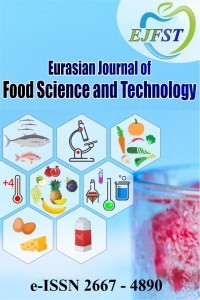Production of Prebiotic Milk and Investigation of Some Properties
Production of Prebiotic Milk and Investigation of Some Properties
Prebiotics are short chain carbohydrates that cannot be digested by human enzymes. They increase the activity of the colonic bacteria, thus provides beneficial physiological effects to the human body. The well-known prebiotics are inulin and fucrooligosaccharides. Those prebiotics are plant polysaccharides and have low-calorie. Prebiotics present several fruits, vegetables and cereals (jerusalem artichoke, onion, etc.) are used in functional food production. Another group of prebiotics, flavonoids, are antioxidants, and are also present in plant materials. Those compounds are responsible for the taste and color of the material. In this research, it was aimed that production of prebiotic milk by the addition of either mentha suaveolens ehrh extracts containing polyphenols or jerusalem artichoke juice containing fructooligosaccharides to its nutrient composition. Single parameter optimization of ultrasonic extraction of mentha suaveolens ehrh. was achieved with the parameters of temperature (45-50-60⁰C), time (5-10-20-30-45-60-75 min) and 1g/10mL solid/liquid ratio by water as a solvent. At the optimum conditions (45⁰C, 45 minute), 19.59mg gallic acid equivalents of polyphenols were extracted per gram of plant. When the extracts added into 5ml of milk drop by drop, it was determined that 3 drops of extracts changed the color of the milk and 9 drops caused a change of the taste. Also, by following the same procedure with jerusalem artichoke juice it was found that 15 drops caused a significant change in both taste and color of the milk. In the light of these preliminary observations, sugarless and sugar-added milk samples were prepared by mixing different kinds of milks (light, half-fat and whole, pasteurized) with either flavonoid or fructooligosaccharides or both, in two different concentrations (5 or 9 drops of flavonoid; 9 or 15 drops of fructooligosaccharide). Those samples were experienced by volunteers for taste and color acceptability. Addionally, the viscosities of milk samples were also measured and compared.
___
- Reference1 Dr Öğr. Üyesi M. Cüneyt BAĞDATLI Nevşehir Hacı Bektaşı Veli Üniversitesi cuneytbagdatli@gmail.com İş Telefonu: 0 384 228 1000/15068
- Reference2 Dr. Öğr. Üyesi İlknur UÇAK Niğde Ömer Halisdemir Üniversitesi ilknurucak@ohu.edu.tr
